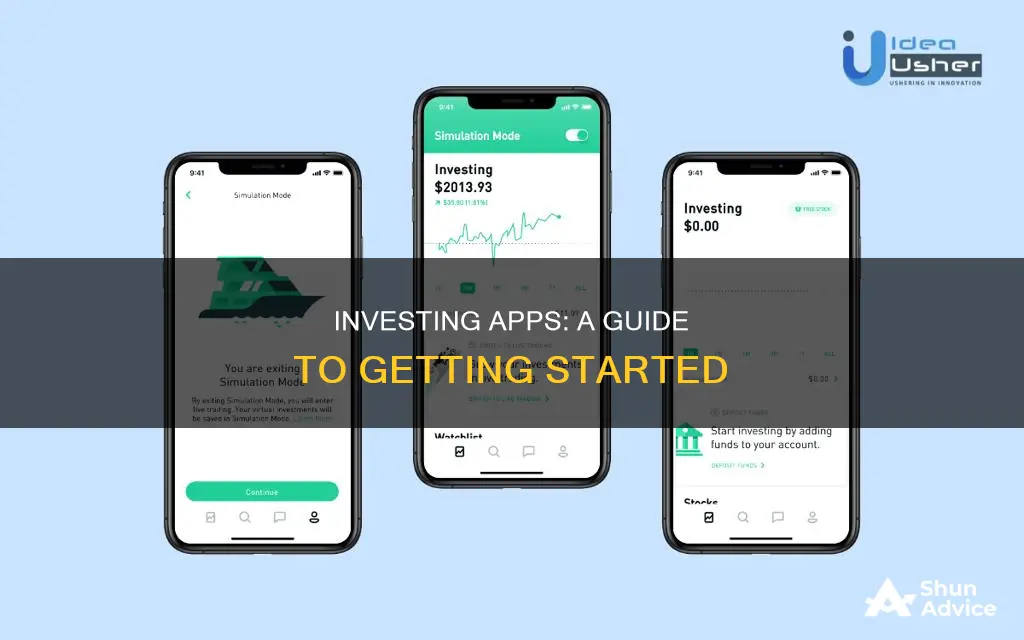
Investment apps are a great way to manage your money and grow your wealth. They are simple and affordable, offering features like easy portfolio diversification, commission-free trading, and straightforward investment strategies.
Here's a step-by-step guide on how to use an investment app:
- Choose an investment app that suits your investment style and needs. Consider factors such as account fees, investment choices, and ease of use.
- Sign up and download the app. Provide personal information and link your bank account to fund your investments.
- Fund your account by deciding how much money you want to invest and transferring funds from your bank. You can also set up automatic recurring contributions.
- Explore the investment options available, such as stocks, bonds, ETFs, and mutual funds. Utilize any educational features or articles within the app to grow your knowledge.
- Build your portfolio by selecting investments that align with your goals, budget, risk tolerance, and investment horizon. Aim for diversification to spread your risk.
- Monitor your portfolio periodically to track its performance and make adjustments as needed.
- Make trades as required, keeping in mind any associated fees and tax implications.
- Stay up-to-date with market news and changes through the app's newsfeed or other resources.
Remember, investing involves risk, so don't invest money you can't afford to lose. Consult a financial advisor if you have any questions.
| Characteristics | Values |
|---|---|
| Choose an app | Compare factors like account fees, investment choices and ease of use |
| Sign up and set up your account | Provide personal information and link your bank account to fund your investments |
| Fund your account | Decide how much money you want to invest and transfer funds from your bank to your investment app |
| Explore investment options | Research and utilise any educational features or articles within the app |
| Build your portfolio | Choose investments that align with your goals, budget and risk tolerance |
| Monitor your portfolio | Check in on your investments and track their performance |
What You'll Learn

Choose an app
When choosing an investment app, it's important to consider your needs, goals, and investment style. Here are some key factors to keep in mind when making your decision:
Usability and User Experience
Look for an app that is easy to use and intuitive. The design should be user-friendly, allowing you to navigate and find the functions you need quickly and logically. A good investment app should also provide a secure login procedure to protect your information.
Fees and Costs
Consider the account fees, investment choices, and transaction costs associated with the app. Compare the fees charged by different apps and choose one that offers low or no fees, especially if you are a beginner investor.
Investment Menu and Trading Ability
Examine the range of investment options available on the app, such as stocks, bonds, ETFs, mutual funds, and alternative investments. Choose an app that aligns with your investment goals and provides access to the types of investments you are interested in.
Educational Resources and Customer Support
If you are new to investing, look for an app that offers educational resources, tutorials, and guides to help you learn about investing and make informed decisions. Additionally, consider the level of customer support provided by the app, including phone, chat, or email assistance.
Security and Safety
Ensure that the app you choose adheres to regulatory requirements and provides protection for your investments. Check if the app is backed by a reputable financial institution and offers security measures such as two-factor authentication and data encryption.
Remember to read reviews, compare features, and consider your own investment needs when selecting an investment app. Taking the time to choose the right app will help you build a solid foundation for your investment journey.
Exploring Federated US Treasury Cash Reserves: Worth the Investment?
You may want to see also

Sign up and set up your account
Signing up and setting up an account on an investment app is a straightforward process. Here's a detailed, step-by-step guide:
Choose an investment app that suits your needs:
Firstly, select an investment app that aligns with your investment goals, style, and preferences. Consider factors such as the app's usability, fees, investment options, trading capabilities, and educational resources. Compare different apps and choose one that best matches your criteria.
Download the app and sign up:
Once you've chosen the app, download it from the app store or official website. Then, create an account by signing up and providing the required personal information. This typically includes basic information such as your name, address, social security number, and bank details.
Set up your account:
After signing up, you'll need to customise and configure your account settings. Link your bank account, debit card, or credit card to the investment app to facilitate fund transfers. You may also want to set up automatic recurring contributions at this stage to ensure regular investments.
Fund your account:
Decide on the amount of money you want to invest initially and transfer funds from your bank to your investment app. You can also set up automatic contributions at this stage to ensure regular investments over time.
By following these steps, you'll be able to sign up, set up, and fund your account on an investment app, laying the foundation for your investment journey.
Fidelity Investments and ChexSystems: What You Need to Know
You may want to see also

Fund your account
Funding your account is a crucial step in using an investment app. Here's a detailed guide on how to do it:
Choose an Investment App
Different investment apps offer distinct features, investment options, and fee structures. Carefully evaluate your needs, investment goals, and risk tolerance before selecting an app. Consider factors such as the app's user-friendliness, regulatory compliance, fund selection, cost, performance tracking, security features, and customer support. Some popular investment apps include Hargreaves Lansdown, Etoro, AJ Bell, and Nutmeg.
Sign Up and Set Up Your Account
Once you've chosen an investment app, download it from the app store and complete the sign-up process. Provide personal information, such as your name, address, social security number, and bank details. You may also need to set up a secure login and provide identification documents for verification.
After setting up your account, it's time to fund it. Decide on the amount you want to invest and transfer funds from your bank account to your investment app. This is also an excellent opportunity to set up automatic recurring contributions to build your investment portfolio over time.
Explore Investment Options
Most investment apps offer a range of investment options, including stocks, bonds, exchange-traded funds (ETFs), mutual funds, and more. Research these options within the app and utilise any educational resources or tools provided to make informed decisions.
Build Your Investment Portfolio
Now comes the exciting part – choosing your investments! Select investments that align with your financial goals, risk tolerance, and investment horizon. Consider diversifying your portfolio to spread your risk. Remember to review your choices periodically and make adjustments as needed to align with your evolving goals.
Monitor Your Portfolio
Regularly check in on your investments using the app. Track their performance and make adjustments as necessary. Stay informed about market news and trends to make strategic decisions. Remember that investing involves risk, so only invest what you can afford to lose.
T. Rowe Price Employee Investment Requirements: What You Need to Know
You may want to see also

Explore investment options
Once you've chosen an app, signed up, and funded your account, it's time to explore the investment options available to you. Most apps offer trading in stocks, bonds, exchange-traded funds (ETFs), and mutual funds. Some apps may also offer alternative investments such as cryptocurrencies, real estate, or commodities. It's important to understand the different types of investments available and how they align with your financial goals and risk tolerance.
When exploring investment options, consider your investment goals and risk tolerance. Are you investing for the short-term or long-term? Are you comfortable with taking on more risk for potentially higher returns, or do you prefer a more conservative approach? Diversification is also key to reducing risk, so aim to spread your investments across different asset classes and sectors.
Utilize the educational resources and tools within the app to grow your knowledge. Many investment apps offer articles, guides, and research reports to help you make informed decisions. Compare different investments and evaluate their potential risks and returns. Consider using features like watchlists and paper trading accounts to track and simulate investments before committing your money.
Remember that investing involves risk, so it's crucial to understand the risks associated with each investment option and ensure that you are comfortable with the level of risk. It's always a good idea to consult with a financial advisor if you need personalized guidance.
Cash Investment Options: Exploring Safe and Smart Strategies
You may want to see also

Build your portfolio
Building a portfolio is a challenging task, but a necessary one if you want to achieve both your short-term and long-term financial goals. Here are some steps to help you build a portfolio using an investment app:
Set Your Goals and Time Horizon:
The first step is to define your financial goals and sort them by time horizon, which is how long you'll need to hold onto your investments before needing the money. This will help you determine the level of risk you're willing to take. For instance, goals that are 30 years away can afford to take on more risk than goals that are only a year away.
Understand Your Risk Tolerance:
Your risk tolerance is how much you're willing to lose in the short term to achieve your goals. Generally, the longer your time horizon, the more aggressive you can be with your investments, while shorter-term goals require a more conservative strategy. It's a balance between achieving your goals and your comfort with market swings.
Choose an Investment App:
There are several types of investment apps to choose from, so pick one that aligns with your goals and risk tolerance. "DIY" apps offer little advice, "robo-assist" apps use AI to analyse the market, and "human advisor apps" provide analytics from real people. Some apps combine these approaches.
Select Your Investments:
Now it's time to choose what to invest in. Stocks, or equities, are units of ownership in a company and tend to offer higher risk with a greater chance of returns. Bonds, on the other hand, are when you lend money to a company or entity in exchange for interest. You can also invest in alternative investments like precious metals, real estate, or cryptocurrencies.
Diversify Your Portfolio:
Don't put all your eggs in one basket. Decide how much of your money to allocate to each type of investment, and then diversify within those asset classes. For example, you could split your stock allocation between large- and mid-cap stocks across multiple sectors like healthcare and technology.
Monitor and Rebalance:
Your portfolio will need ongoing care and attention. Check in regularly to ensure your investments are still aligned with your goals, and rebalance if necessary. You may also need to adjust your strategy as your life changes, such as when you get married, have children, or near retirement.
Tips for Using an Investment App:
- Look for an app with a user-friendly interface that's easy to navigate and understand.
- Ensure the app supports the financial services you use, such as banks, e-wallets, and crypto wallets.
- Choose an app that provides market analysis and news feeds to help you make informed decisions.
- Consider an app with a virtual advisor or chatbot to guide you.
- Look for apps with push notifications to keep you updated on market news and your favourite investments.
- For added security, look for apps that offer biometric authentication, two-factor authentication, or fingerprint and PIN protection.
Investment Bankers: Key Facilitators in the Acquisition Process
You may want to see also
Frequently asked questions
You can open an investing app account by downloading the app from your app store of choice and signing up. You will need to provide personal information such as your name, address, social security number, and bank information.
Using an investing app involves choosing an app that suits your investment style and needs, signing up, setting up your account, exploring investment options, building your portfolio, monitoring your portfolio, and making trades. It's important to stay informed about market news and changes and to consult with a financial advisor if you have any questions or concerns.
The investments available through an investing app can vary, but most traditional brokers offer a wide range of options, including stocks, bonds, exchange-traded funds (ETFs), mutual funds, options, and futures. Some apps also offer cryptocurrency trading, but it's recommended to use a dedicated crypto exchange for that purpose.







